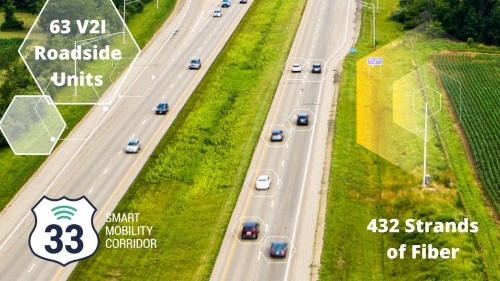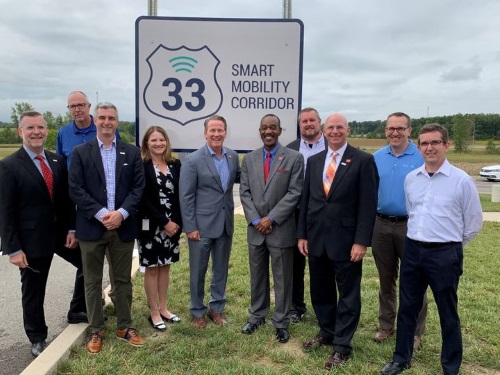The recently opened 33 Smart Mobility Corridor in central Ohio is a connected highway project that seeks to enhance motor vehicle safety, reduce traffic congestion, and improve fuel economy.
[Above photo by DriveOhio]
This connected highway project – overseen by InnovateOhio, which coordinates service integration among state agencies – involves the Ohio Department of Transportation, DriveOhio, the U.S. Department of Transportation, and the NW 33 Council of Governments, among others.
With a 35-mile redundant loop of fiber connectivity, the corridor includes 432 strands of available fiber, 63 roadside units, and 45 connected intersections. The route also encompasses diverse geographical and meteorological scenarios to provide a one-of-a-kind vehicle testing “ecosystem” for developing and testing smart mobility technology.
“Transportation is evolving, and mobility technology solutions that have and will be tested on the 33 Smart Mobility Corridor will save lives,” noted Jack Marchbanks, Ohio DOT’s director, in a statement. “The partnership framework we have established during this project is a model for future programs across the state, as we work to improve the quality of life for all Ohioans.”

“We know that connected and automated vehicle technology will continue to mature and scale at an ever-increasing pace,” added Howard Wood, executive director of DriveOhio, which is a division of the Ohio DOT. “As these systems are tested and refined, infrastructure plays a major role in the development cycle as mobility technology interphases with our legacy transportation system.”
“[This] corridor enables us to conduct real-world testing of our SAFE SWARM technology, which uses vehicle-to-everything communication to help mitigate collisions, improve traffic flow, increase fuel efficiency for all road users, and prepare for higher-levels of automated driving features,” said Sue Bai, chief engineer at Honda Research Institute USA, Inc.
Currently, Honda is operating over 200 connected vehicles along the corridor to understand how technology impacts the customer and realize a connected ecosystem that protects everyone sharing the road, including pedestrians, motorcycles, and bicyclists.
“This initiative is helping us develop the transportation ecosystem of the future with like-minded partners in the auto industry, government, academia, and the private sector,” Bai added.

